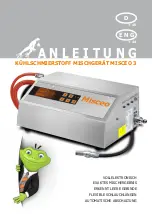
10. Manuel emergency lowering.
If the hydraulic pump is not working the platform can be brought
to the ground via the manual handpump system, by following
the below procedure.
WHEN OPERATION THE PLATFORM FROM THE
GROUND, BY ENGAGING ON THE HYDRAULIC VALVES
DIRECTLY, THE SAFETYSYSTEM OF THE PLATFORM IS
OUT OF FUNCTION.
WHEN OPERATING THE PLATFORM DIRECTLY ON THE
HYDRAULIC VALVES, “TELESCOPE IN” IS THE ONLY
FUNCTION TO BE USED UNTIL THE TELESCOPE IS
FULLY RETRACTED. FAILURE TO DO SO, CAN CAUSE
PERSONNEL INJURY OR DEATH.
CALL AUTHORISED MAINTENANCE IMMEDIATELY.
Before starting any manual emergency procedure the
platform must always be stabilised, as follows:
1.
Telescopic arm in.
2.
Main arm up.
1.
Check that the locking screw (Fig. 2.5) on the hand pump
is locked to the flght.
2.
Open up the emergency control valve (Fig. 2.1).
3.
Activate the valve block (Fig. 1.2) function according to the
sign (Fig. 1.3).
4.
Pump the handle (Fig. 2.6).
Main arm in/sleewing turret:
1.
Check that the locking screw (Fig. 2.5) on the hand pump
is locked to the fight.
2.
Open up the emergency control valve (Fig. 2.1).
3.
Push valve (Fig. 2.2).
4.
Activate the valve block (Fig. 1.2) function according to the
sign (Fig. 1.3).
5.
Pump the handle (Fig. 2.6).
Once the procedure is complete, turn off the ball plug
valve (8) that is positioned crosswise.
3.3 AFTER OPERATING THE SPIDER.
1.
Bring the basket down: telescope in and place main boom
in the seat and bring the basket to the ground, but never
on the ground.
DO NOT BRING THE BASKET DOWN INTO THE
GROUND. THIS CAN CAUSE STRUCTURAL
DAMAGE TO THE SPIDER.
2.
Take the basket off and rotate the swing jib in itís seat.
IMPORTANT NOTICE
3.
Lift the outriggers off the ground and loosen the hinged joints.
Lift the outriggers all the way up to stowed position and
lock the toggle joints.
4.
For entering narrow places the outriggers can be swung
parallel to the base and locked into position. The footplates
can be removed if most narrow position is required.
5.
Now the SPIDER is ready for transport.
6.
If the SPIDER only has to be moved a short distance for the
next job, it is only necessary to take the outriggers off the
ground a few inches/centimetres and then drive the
SPIDER to the next place if space allows.
When the SPIDER is transported, the outriggers shall be raised
a minimum of 5 cm above the ground.
3.4 DRIVING THE SPIDER – SELF-PROPELLED DRIVE.
1.
The
SPIDER
is self-propelled via a helm station, which
means that it can lift itself on and off a truck, trailer, etc. and
be moved to ajob site and back.
2.
To change the axle width on rear set of wheels, lift the
wheels off the ground with the outriggers. See instructions
for setting up the SPIDER. (Section E). Remove locking pin
for rear axles and adjust the axle with to the needed with
and lock axle position with locking pin.
REAR AXLES NOT LOCKED WITH THE LOCKING PIN,
CAN MAKE THE REAR AXLE FALL OUT AND THE
PLATFORM MAY TIP SERIOUS INJURY OR DEATH.
MAKE SURE THAT REAR AXLES ARE
ALWAYS LOCKED LOCKING PIN.
3.
Always use the maximum possible axle width that
space allows.
WHEN DRIVING THE SPIDER WITH THE AXLES IN THE
STOWED POSITION, KEEP THE PLATFORM ON HARD,
FLAT GROUND AND IN LOW SPEED. IF THE PLATFORM
IS DRIVEN ON A SLOPE IT CAN TIP OVER AND CAUSE
INJURY OR DEATH. USE THE WIDEST AXLE WIDTH
POSSIBLE AT ALL TIMES.
4.
Turn on the power by using the main-key.
5.
On the helm station there are two directional switches for
two speed forward and reverse drive.
6.
3 wheel drive (option)
CAUTION
8






























